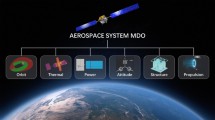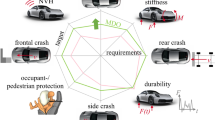Abstract
Automotive companies continuously strive to design better products faster and more cheaply using simulation models to evaluate every possible aspect of the product. Multidisciplinary design optimization (MDO) can be used to find the best possible design taking into account several disciplines simultaneously, but it is not yet fully integrated within automotive product development. The challenge is to find methods that fit company organizations and that can be effectively integrated into the product development process. Based on the characteristics of typical automotive structural MDO problems, a metamodel-based MDO process intended for large-scale applications with computationally expensive simulation models is presented and demonstrated in an example. The process is flexible and can easily fit into existing organizations and product development processes where different groups work in parallel. The method is proven to be efficient for the discussed example and improved designs can also be obtained for more complex industrial cases with comparable characteristics.









Similar content being viewed by others
References
Craig K, Stander N, Dooge D, Varadappa S (2002) MDO of automotive vehicle for crashworthiness and NVH using response surface methods. Paper AIAA-2002-5607 In: A collection of technical papers, 9th AIAA/ISSMO symposium on multidisciplinary analysis and optimization, Atlanta, Georgia, 4–6 September 2002, vol 3. American Institute of Aeronautics and Astronautics, Reston, pp 1930–1940
Sheldon A, Helwig E, Cho Y-B (2011) Investigation and application of multi-disciplinary optimization for automotive body-in-white development. In: Paper presented at the 8th European LS-DYNA Users conference, Strasbourg, 23–24 May 2011
Sobieszczanski-Sobieski J, Kodiyalam S, Yang RY (2001) Optimization of car body under constraints of noise, vibration, and harshness (NVH), and crash. Struct Multidiscip Optim 22(4):295–306
Yang RJ, Gu L, Tho CH, Sobieszczanski-Sobieski J (2001) Multidisciplinary design optimization of a full vehicle with high performance computing. Paper AIAA-2001-1273 In: A collection of technical papers, 42nd AIAA/ASME/ASCE/AHS/ASC structures, structural dynamics, and materials conference and exhibit, Seattle, Washington, 16–19April, 2001. American Institute of Aeronautics and Astronautics, Reston, pp 688–698
Kodiyalam S, Yang RJ, Gu L, Tho C-H (2004) Multidisciplinary design optimization of a vehicle system in a scalable, high performance computing environment. Struct Multidiscip Optim 26(3):256–263
Hoppe A, Kaufmann M, Lauber B (2005) Multidisciplinary optimization considering crash and NVH loadcases. In: On CD: Virtual product creation 2005, internationaler congress, 9th automotive technology conference, 20–21 June 2005, Stuttgart. Vieweg Technology Forum, Wiesbaden
Duddeck F (2008) Multidisciplinary optimization of car bodies. Struct Multidiscip Optim 35(4):375–389
Weber J (2009) Automotive development processes: processes for successful customer oriented vehicle development. Springer, Berlin
Hirz M, Dietrich W, Gfrerrer A, Lang J (2013) Integrated computer-aided design in automotive development: development processes, geometric fundamentals, methods of CAD, knowledge-based engineering data management. Springer, Berlin
Jergeus J (2012) Prediction material and spotweld failure at Volco Cars Safety Center, Presentation held at 2012 Nordic LS-Dyna users’ forum, Gothenburg, 11 October 2012
Wang GG, Shan S (2007) Review of metamodeling techniques in support of engineering design optimization. J Mech Des 129(4):370–380
Myers RH, Montgomery DC, Anderson-Cook CM (2009) Response surface methodology: process and product optimization using designed experiments, 3rd edn. Wiley, Hoboken
Hornik K, Stinchcombe M, White H (1989) Multilayer feedforward networks are universal approximators. Neural Netw 2(5):359–366
Park J, Sandberg IW (1991) Universal approximation using radial-basis-function networks. Neral Comput 3(2):246–257
Xie T, Yu H, Wilamowski B (2011) Comparison between traditional neural networks and radial basis function networks. In: Proceedings of the 2011 IEEE international symposium on industrial electronics (ISIE), Gdansk, 27–30 June 2011. Institute of Elecrtrical and Electronics Engineers, Piscataway, pp 1194–1199
Sacks J, Welch WJ, Mitchell TJ, Wynn HP (1989) Design and analysis of computer experiments. Stat Sci 4(4):409–423
Smola AJ, Schölkopf B (2004) A tutorial on support vector regression. Stat Comput 14(3):199–222
Friedman JH (1991) Multivariate adaptive regression splines. Ann Stat 19(1):1–67
Forrester AIJ, Keane AJ (2009) Recent advances in surrogate-based optimization. Prog Aerosp Sci 45(1–3):50–79
Qian PZG, Wu H, Wu CFJ (2008) Gaussian process models for computer experiments with qualitative and quantitative factors. Tecnometrics 50(3):383–396
Herrera M, Guglielmetti A, Xiao M, Coelho RF (2014) Metamodel-assisted optimization based on multiple kernel regression for mixed variables. Struct Multidiscip Optim 49(6):979–991
Koehler JR, Owen AB (1996) Computer experiments. In: Gosh S, Rao CR (eds) Design and analysis of experiments. Handbook of statistics, vol 13. Elsevier, Amsterdam, pp 261–308
Kalagnanam JR, Diwekar UM (1997) An efficient sampling technique for off-line quality control. Technometrics 39(3):308–319
Fang K-T, Lin DKJ, Winker P, Zhang Y (2000) Uniform design: theory and application. Technometrics 42(3):237–248
Queipo NV, Haftka RT, Shyy W, Goel T, Vaidyanathan R, Tucker PK (2005) Surrogate-based analysis and optimization. Prog Aerosp Sci 41(1):1–28
Martin JD, Simpson TW (2004) On the use of Kriging models to approximate deterministic computer models. Paper DETC2004 -57300 In: Proceedings of the ASME 2004 international design engineering technical conferences and computers and information in engineering conference, Salt Lake City, Utah USA, September 28–October 2, 2004, vol 1. American Society of Mechanical Engineers, New York, pp 481–492
Goel T, Stander N (2009) Comparing three error criteria for selecting radial basis function network topology. Comput Method Appl Mech Eng 198(27–29):2137–2150
Stander N, Craig KJ (2002) On the robustness of a simple domain reduction scheme for simulation-based optimization. Eng Computation 19(4):431–450
Kennedy J, Eberhart R (1995) Particle swarm optimization. In: Proceedings of the 1995 IEEE international conference on neural networks, Perth, WA, 27 November–1 December 1995. Institute of Electrical and Electronics Engineers Service Center, Piscataway, pp IV:1942–1948
Ingber L (1996) Adaptive simulated annealing (ASA): lessons learned. Control Cybern 25(1):32–54
Eiben AE, Smith JE (2003) Introduction to evolutionary computing. Springer, Berlin
Kodiyalam S, Sobieszczanski-Sobieski J (2001) Multidisciplinary design optimization—some formal methods, framework requirements, and application to vehicle design. Int J Veh Des 25(1–2, special issue):3–22
Sobieszczanski-Sobieski J (1988) Optimization by decomposition: a step from hierarchic to non-hierarchic systems. Technical memorantum NASA-TM-101494. NASA Langley Research Center, Hampton
Sobieszczanski-Sobieski J, Agte JS, Sandusky Jr, RR (1998) Bi-level integrated system synthesis (BLISS). Paper AIAA-98-4916 In: 7th AIAA/USAF/NASA/ISSMO symposium on multidisciplinary analysis and optimization, 2–4 September, 1998, St. Louis, MO. American Institute of Aeronautics and Astronautics, Reston, pp 1543–1557
Braun RD (1996) Collaborative optimization: an architecture for large-scale distributed design. Dissertation, Stanford University
Kim HM (2001) Target cascading in optimal system design. Dissertation, University of Michigan
Martins JRRA, Lambe AB (2013) Multidisciplinary design optimization: a survey of architectures. AIAA J 51(9):2049–2075
DeMiguel A-V, Murray W (2000) An analysis of collaborative optimization methods. Paper AIAA-2000-4720 In: 8th AIAA/USAF/NASA/ISSMO symposium on multidisciplinary analysis and optimization, 6–8 September, 2000, Long Beach, CA. American Institute of Aeronautics and Astronautics, Reston
Alexandrov NM, Lewis RM (2002) Analytical and computational aspects of collaborative optimization for multidisciplinary design. AIAA J 40(2):301–309
Kroo I, Manning V (2000) Collaborative optimization: status and directions. Paper AIAA-2000-4721 In: 8th AIAA/USAF/NASA/ISSMO symposium on multidisciplinary analysis and optimization, 6–8 September, 2000, Long Beach, CA. American Institute of Aeronautics and Astronautics, Reston
Jin R, Chen W, Simpson TW (2001) Comparative studies of metamodelling techniques under multiple modelling criteria. Struct Multidiscip Optim 23(1):1–13
Stander N, Roux W, Goel T, Eggleston T, Craig K (2012) LS-OPT user’s manual version 4.2. Livermore Software Technology Corporation, Livermore
Sjödin T (2010) Saab 9-5 virtual development without hardware prototypes, Presentation held at NAFEMS Nordic regional conference 2010, Gothenburg, 26–27 October 2010
Livermore Software Technology Corporation (2007) LS-DYNA keyword user’s manual version 971. Livermore Software Technology Corporation, Livermore
Viana FAC, Gogu C, Haftka RT (2010) Making the most out of surrogate models: tricks of the trade. Paper DETC2010-28813 In: Proceedings of the ASME 2010 international design engineering technical conferences and computers and information in engineering conference, Montreal, Quebec, Canada, August 15–18, 2010, vol 1. American Society of Mechanical Engineers, New York, pp 587–598
Craig KJ, Stander N, Dooge DA, Varadappa S (2005) Automotive crashworthiness design using response surface-based variable screening and optimization. Eng Comput 22(1):38–61
Daniel C (1973) One-at-a-time plans. J Am Stat Assoc 68(342):353–360
Sobol’ IM (2001) Global sensitivity indices for nonlinear mathematical models and their Monte Carlo estimates. Math Comput Simul 55(1–3):271–280
Gu L, Yang RJ (2006) On reliability-based optimisation methods for automotive structures. Int J Mater Prod Technol 25(1–3):3–26
Shi L, Yang RJ, Zhu P (2012) A method for selecting surrogate models in crashworthiness optimization. Struct Multidiscip Optim 46(2):159–170
Yang RJ, Wang N, Tho CH, Bobineau JP, Wang BP (2005) Metamodeling development for vehicle frontal impact simulation. J Mech Des 127(5):1014–1020
Li YF, Ng SH, Xie M, Goh TN (2010) A systematic comparison of metamodeling techniques for simulation optimization in decision support systems. Appl Soft Comput 10(4):1257–1273
Backlund PB, Shahan DW, Seepersad CC (2011) A comparative study of the scalability of alternative metamodelling techniques. Eng Optim 44(7):767–786
Zhu P, Pan F, Chen W, Zhang S (2012) Use of support vector regression in structural optimization: application to vehicle crashworthiness design. Math Comput Simul 86:12–31
Agte J, de Weck O, Sobieszczanski-Sobieski J, Arendsen P, Morris A, Spieck M (2010) MDO: assessment and direction for advancement-an opinion of one international group. Struct Multidiscip Optim 40(1–6):17–33
Acknowledgments
The work presented in this article has been carried out with financial support from the Vinnova FFI project ‘Robust and multidisciplinary optimization of automotive structures’ and the SSF ProViking project ‘ProOpt’.
Author information
Authors and Affiliations
Corresponding author
Rights and permissions
About this article
Cite this article
Ryberg, AB., Bäckryd, R.D. & Nilsson, L. A metamodel-based multidisciplinary design optimization process for automotive structures. Engineering with Computers 31, 711–728 (2015). https://doi.org/10.1007/s00366-014-0381-y
Received:
Accepted:
Published:
Issue Date:
DOI: https://doi.org/10.1007/s00366-014-0381-y




